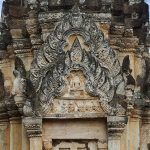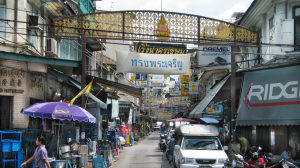
The much treasured old city of Sukhothai is 12 km from the ‘new’ city along Highway 12. It has its place in Thai history as being the capital of the first independent Thai Kingdom. From the middle of the 13th to the end of the 14th centuries the Sukhothai kingdom has been considered the ‘Golden Age’ of Thai civilisation. The ruins of this once great city, along with the architectural splendours surrounding it, were designated as a World Heritage Site by UNESCO.
Between the 9th and 10th centuries Sukhothai was under Khmer sovereignty, which can be noted in the many Khmer style prangs located in the historical park. The Tai’s moved into the area around the beginning of the 11th century, when they were believed to have migrated from states in Southern China. Later, in 1240, according to legend, the Tai King Indradit defeated the Khmer chief in a duel on elephant. King Indradit then built Wat Mahatat as the centre of this new kingdom.
King Ramkhamhaeng, the son of King Indratit and the most famous of the nine kings of the Sukhothai Dynasty, expanded the kingdom to almost the present day boundaries of Thailand. He invited monks from Ceylon to preach Theravada Buddhism, which became predominant and united the people. The city flourished, the people content and harmonious. This period gave the influence and inspiration to the artists and sculptors, who reflected it in the elegant styles of religious art and architecture labelled as Sukhothai style. Ramkhamhaeng is also credited to the development of the Thai script, which he derived from Mon and Khmer scripts.
In 1378, the frontier city, Kamphaengphet, was taken over by King Borommaracha I (U-thong) of Ayutthaya. Eventually Sukhothai would become a vassal state of Ayutthaya.
Places of Attraction

Ramkhamhaeng Museum
For visitors to the Historical Park, a stop at this museum before wandering around the ruins is recommended. The museum holds a copy of the famous Ramkhamhaeng’s stela inscription, as well as many artefacts from the Sukhothai and Khmer periods.
Sukhothai Wats
Wat Mahatat
This was the centre of the Sukhothai Kingdom, not only in the religious sense but also the political. The construction of the complex was started by King Indradit and finally completed by King Lo Thai around 1345. The whole complex, containing nearly 200 chedis, 10 viharns and a multitude of other structures, is enclosed by a moat and brick walls.

Wat Trapang Thong
Located next to the Ramkhamhaeng Museum, this active monastery is placed on an island in the middle of a large lotus-filled pond. The ruined Ceylonese-style laterite chedi is fronted by a mondop containing a Buddha footprint slab created by King Li Tai in 1390. An annual festival to worship the footprint coincides with the Loi Krathong festivities in November.
Wat Sra Sri
The wat sits on a small island to the west of the King Ramkhamhaeng Monument. The complex is dominated by a Ceylonese-style chedi. There is also a large seated Buddha image enclosed within the ruined columns of the viharn.
Wat Sri Sawai
Built in the time of Khmer dominance, the temple grounds contain three prangs, the largest of which is the central prang, standing at 20 m high. The prangs were decorated with stucco decorations during the 15th century. Originally it was a Hindu shrine before it was converted into a Buddhist shrine.
Wat Sri Chum
Situated in the north west of the old city. The large impressive mondop encloses a 15 m seated Buddha image, made from brick and stucco. The image, in the attitude of subduing Mara, is believed to be the Phra Atchana, mentioned in Ramkhamhaeng’ famous inscription. A staircase leading to space behind the image’s head, revealing line carvings of the Jataka tales (stories of Buddha’s previous life episode), has now been blocked.

Wat Phra Pai Luang
This temple dates back to before the rise of the Sukhothai kingdom. Built during the reign of the Khmer King Jayavarman VII, it was probably the principal structure during the Khmer period. The site is interesting for the remains of the three prangs, of which the northern prang retains some of the original fine stucco work. The temple grounds also contain over 30 stupas of various styles.
Wat Saphan Hin
This temple is located to the west of the old city, perched on top of a hill overlooking the plain. The name means ‘stone bridge’, in reference to the slate path and staircase that leads to the temple and remains intact today. The remnants consist of a few chedis, a ruined viharn and a 12.5 m high standing Buddha image.
Si Satchanalai
Si Satchanalai, the twin city of Sukhothai, lies 50 km to the north of Sukhothai. The site was probably built on the former Khmer town of Chaliang. Located on the east bank of the Yom River and surrounded by a 10 metre deep moat and walls three rows thick, the site was heavily defended. The city was linked to Sukhothai by a 50km long road, the Phra Ruang highway. The city has become famous for the ceramics produced in the nearby villages of Ban Ha Yang and Ban Ko-Noi, to the north. These are said to be the finest produced in the kingdom, known as Sawankhalok ware. Along with Sukhothai it has been declared a World Heritage Site by UNESCO.
Wat Chang Lom
This temple lies in the centre of the old city and is the most sacred in Si Satchanalai. The main chedi was built by King Ramkhamhaeng between 1285 and 1291. The chedi is said to hold sacred relics of Buddha, which -according to his famous Inscription No. 1- he dug up, worshipped them for a month and 6 days, then buried. The chedi was then built over them. The chedi – the first Ceylonese style chedi to be found in Thailand – has a base supported by 39 elephants and niches enshrining images in the attitude of subduing Mara.
Wat Chedi Jet Thaew
The wat contains the remnants of 34 chedis, which contain the ashes of the Si Satchanalai ruling family and was most likely built by King Li Thai. The 14th century mondop displays a mixture in architectural styles: from the Khmer and Sukhothai archway, to the Ceylonese bell and tower which crown it.

Wat Khao Phanom Phloeng
This temple is located on a small hill, to the north of town. The approach to the temple is by a laterite staircase, with a total of 144 steps. The ruins include a large seated Buddha and a Ceylonese-style chedi. Archaelogical excavations have revealed an animistic shrine, indicating that Si Satchanalai was inhabited before the Khmer period.
Wat Nang Phaya
This temple, in the southern part of the city, probably dates back to the 15th century. The site is dominated by a large Ceylonese-style chedi. On the western wall of the laterite viharn are beautiful stucco floral reliefs.
Wat Phra Si Ratana Mahathat
Located further along the Yom River at Chaliang. The large laterite prang probably dates back to the mid 15th century (during the reign of King Boromtrailokant), although it was believed to have been built over an earlier Khmer prasat. Amongst the ruins of the viharn, in front of the prang, is a large seated Sukhothai-style Buddha image and a smaller walking Buddha.
Wat Chao Chan
Located to the east of the fortified town, at Chaliang. The large Khmer-style prang is believed to have been built during the reign of the Khmer King Jayavarman VII (1181-1217).
Virtual Tour
Resources:






Add Comment